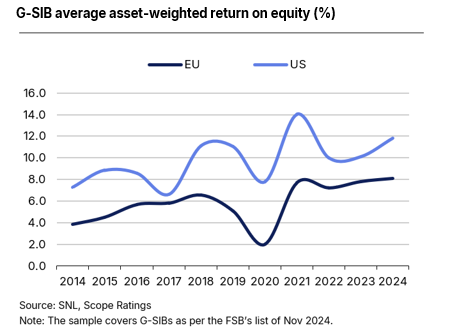Announcements
Drinks

Bank Capital Quarterly: regulatory simplification treads a fine line
“We welcome EU regulatory simplification, including from a credit-risk perspective,” said Magnus T Rising, an analyst in Scope’s financial institutions team. “We expect positive outcomes from simpler regulation, but there is a risk that measures could result in new inefficiencies or less resilient banks. While the potential for missteps should not be overlooked, if done right, the benefits of simplification include not just lower regulatory hurdles for bank profitability and competitiveness but better oversight, more transparency and comparability across banks.
The scope of banking regulation has significantly expanded over the years: the 2024 EU Banking Package involved about 1,000 pages of new legislation and about 140 new EBA mandates, double what was in the 2019 version. But policy makers and officials maintain a clear distinction between capital complexity and overall capital requirements.

The ECB’s High-Level Task Force on Simplification and the EBA’s 21-point roadmap pave the way for reforms across Pillar 2, macroprudential buffers and reporting, with objectives to improve proportionality and enhance predictability without weakening resilience. “Importantly, EU officials and policy makers have not endorsed a lowering of prudential standards, instead focusing on reducing procedural complexity, eliminating overlaps, and improving proportionality,” Rising pointed out.
The task force is assessing possible cumulative regulatory impacts across prudential, resolution, and reporting domains and mapping overlaps between requirements. Expected recommendations will address how to streamline capital structures, Pillar 2 requirements, macroprudential buffer co-ordination, and integrate reporting frameworks. Recommendations are likely to influence the 2026-27 EU policy agenda.
The EBA’s recommendations provide operational detail and timelines, targeting materiality assessments, a 25% reduction in reporting costs, a review of the Single Rulebook and internal organisation improvements. The 25% cost target will be pursued by reducing and simplifying requirements, establishing a public EU-wide repository of supervisory data requests, and improving change management to decrease frequency and increase predictability of updates.
“In principle, the better transparency and comparability emanating from simplification should lead to greater market discipline. A shift in priorities to emphasise risk ownership and accountability over compliance while helping to limit regulatory arbitrage are other possible benefits,” Rising said.
Key policy risks remain, however. Reducing risk sensitivity to simplify capital would inevitably lead to less efficient capital allocation and pricing. Undoing parallel requirements overlooks the value of a multi-restrictive framework. “Trimming the granularity or frequency of Pillar 3 disclosure could undermine market discipline. And if effective simplification cannot be distinguished from deregulation, the cost-benefit trade-off for resilience becomes ambiguous. If so, we may see limited efficiency gains from simplification or a gradual drift towards deregulation,” Rising said.
Removing AT1s from the capital stack
One potential step on the simplification agenda would be removing AT1 instruments from EU banks’ capital stack. This aligns with mounting evidence that AT1s have limited effectiveness as going-concern capital. “The Swiss court ruling regarding Credit Suisse AT1s is an encouraging development, potentially reversing hierarchy inversion and safeguarding property rights,” Rising said.
“While the former is key to market efficiency, the latter is critical to institutional integrity and economic development in the long term. At the same time, the ruling adds to the evidence that AT1s, in practice, do not absorb losses outside of resolution or insolvency proceedings.”






